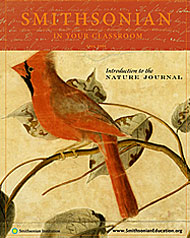
This Smithsonian in Your Classroom is the third in a three-part
series that brings together writing and other disciplines. In the
lessons here, students exercise the observation skills that are
essential to writing, visual art, and science. First, they try to
use evocative language in describing pictures of birds from the
Smithsonian’s National Zoo. They go on to record observations and
to make hypotheses as they follow the behavior of animals on the
National Zoo’s live webcams. They can watch the giant pandas, the
tigers, the cheetahs, the gorillas, or any of a dozen other species.
These classroom activities are intended as a preface
or complement to a project increasingly popular
in elementary and middle schools—the keeping of
nature journals, whether on class outings or when
the students are on their own. Included in the issue
are words of advice for students from journal-keeping
Smithsonian naturalists.
The term nature journal seems to resist definition
until we realize that the broadest definitions all
apply. In Keeping a Nature Journal, the most popular
recent book on the subject, Clare Walker Leslie
puts it simply: “whereas a diary or personal journal
records your feelings toward yourself and others, a nature journal primarily records your responses to and
reflections about the world of nature around you.”
With a subject as great as all outdoors, nature journals
lend themselves to a wide range of expression.
Sketches are often the most immediate way to capture
the way things look. Deeper, written observations can
be the basis for all kinds of creative writing.
Electronic versions of the previous issues in this
series are available for free download here:
|
 |
 |
 |
 |

Smithsonian in Your Classroom is produced by the Smithsonian Center for Education and Museum Studies. Teachers may duplicate the materials for educational purposes.
|
 |
 |
 |
|

